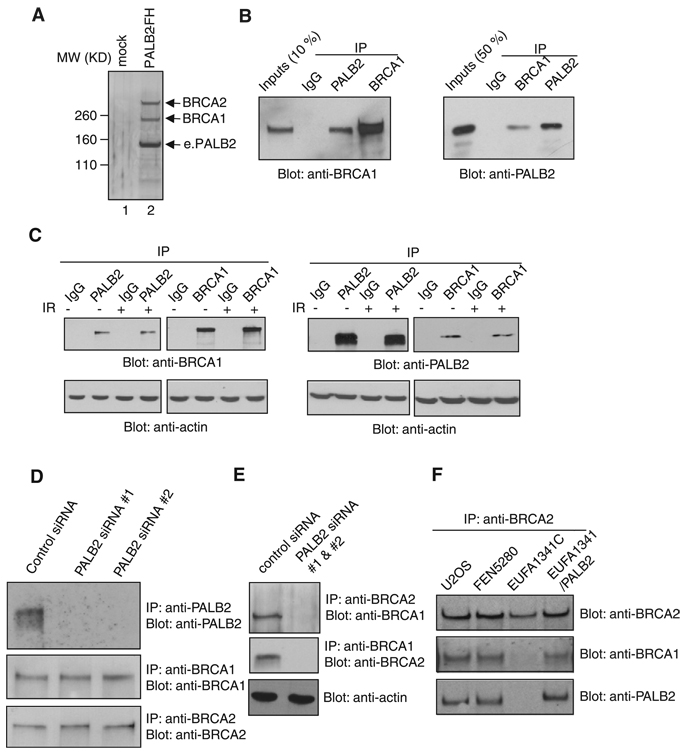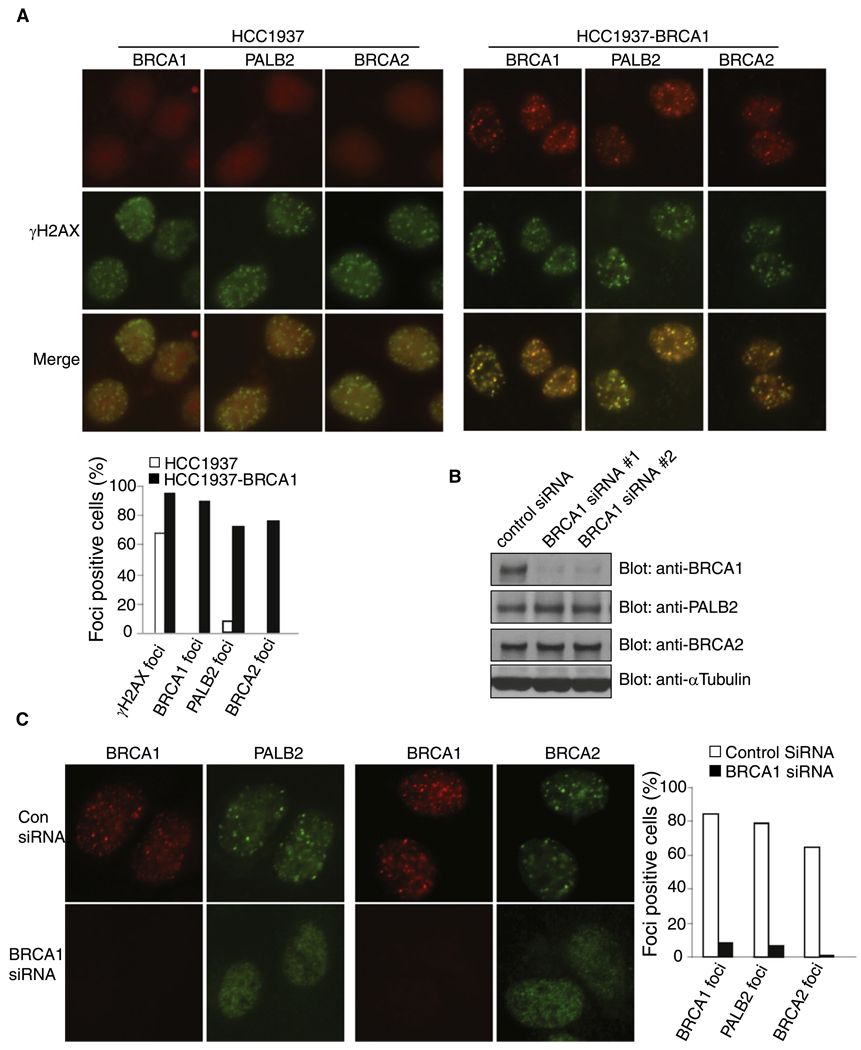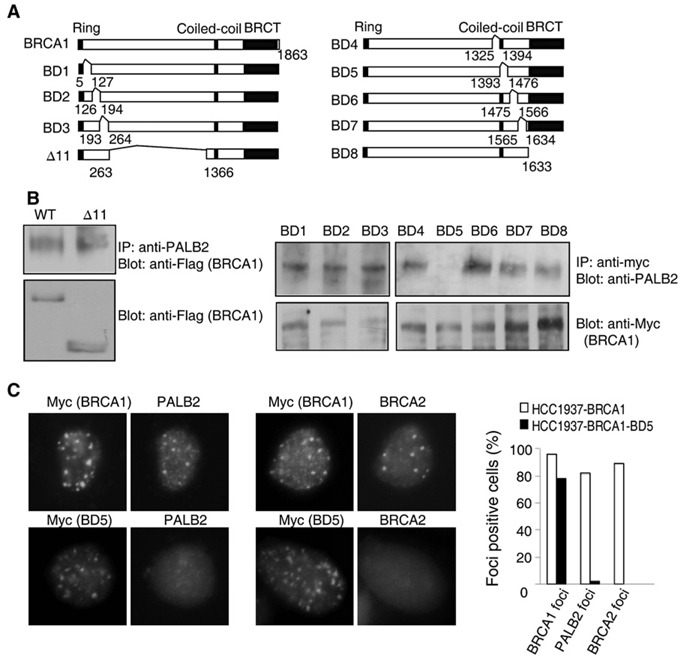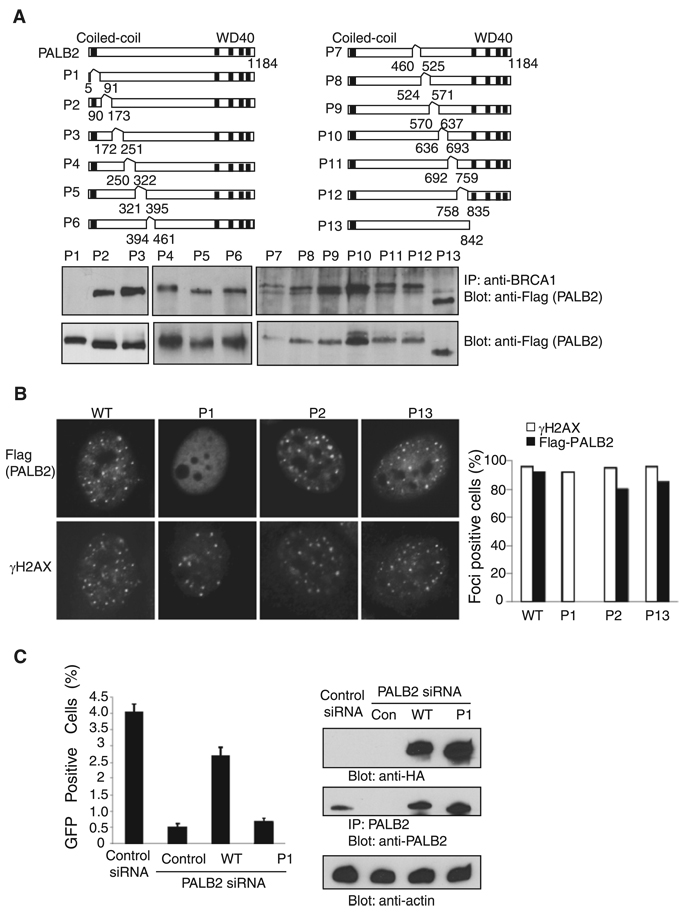Summary
BRCA1 and BRCA2 are often mutated in familial breast and ovarian cancer. Both tumor suppressors play key roles in the DNA-damage response [1, 2]. However, it remains unclear whether these two tumor suppressor function together in the same DNA-damage response pathway. Here, we show that BRCA1 associates with BRCA2 through PALB2/FANCN, a major binding partner of BRCA2 [3]. The interaction between BRCA1 and BRCA2 is abrogated in PALB2-deficient Fanconi anemia cells and in the cells depleted of PALB2 by small interfering RNA. Moreover, we show that BRCA1 promotes the concentration of PALB2 and BRCA2 at DNA-damage sites and the interaction between BRCA1 and PALB2 is important for the homologous recombination repair. Taken together, our results indicate that BRCA1 is an upstream regulator of BRCA2 in the DNA-damage response, and PALB2 is the linker between BRCA1 and BRCA2.
Results and Discussion
PALB2 Interacts with BRCA1
Recently, by protein affinity purification, PALB2 has been identified as a functional partner of BRCA2 [3]. Importantly, germline mutations of PALB2 have been found in breast cancer families, indicating that PALB2, like BRCA1 and BRCA2, is a tumor suppressor for familial breast cancers [4–6]. In addition, BRCA2 is also the Fanconi anemia D1 protein (FANCD1), given that the D1 subtype of FA (FA-D1) has been attributed to biallelic germline mutations in BRCA2 [7]. Interestingly, like BRCA2, PALB2 is also a FA protein, given that biallelic germline mutations in PALB2 have been identified in the N subtype of FA (FA-N) [8, 9].
To identify additional PALB2 binding proteins, we used two different protein affinity purification approaches to search for PALB2-associated proteins. In one approach, we purified Flag-HA-tagged PALB2 from HeLa S3 cells. In the purified complex, we observed two major components with molecular weights higher than PALB2 (Figure 1A). Mass spectrometry analysis demonstrated that the upper band represented BRCA2, a known PALB2 binding partner [3], and the lower band, to our surprise, was BRCA1. Alternatively, we purified S-SPB-tagged PALB2 protein complex from 293T cells and also identified BRCA1 and BRCA2 as PALB2-associated proteins (data not shown). To confirm that PALB2 interacts with BRCA1 under the physiological condition, we performed reciprocal immunoprecipitation (IP) of the endogenous proteins and found that they indeed co-IPed with each other (Figure 1B). Because both PALB2 and BRCA1 participate in the DNA-damage response, we tested whether DNA double-strand breaks influence the interaction between these two proteins. As shown in Figure 1C, the association between PALB2 and BRCA1 did not change after ionizing radiation (IR), indicating that, like the interaction between PALB2 and BRCA2, the interaction between PALB2 and BRCA1 is DNA-damage independent and occurs constitutively.
Figure 1. PALB2 Mediates the Interaction between BRCA1 and BRCA2.
(A) Silver staining of affinity-purified PALB2 complexes. The nuclear extracts prepared from naive HeLa S3 cells or cells stably expressing PALB2-FLAG-HA were subjected to two rounds of affinity purification. Final elutes were resolved by SDS-PAGE and stained with silver. The protein bands were analyzed by mass spectrometry. Arrows indicate protein bands corresponding to BRCA1, BRCA2, and PALB2.
(B) PALB2 interacts with BRCA1. 293T cell lysates were analyzed by immunoprecipitation (IP) and western blotting with PALB2 or BRCA1 antibodies respectively. Whole-cell lysates were blotted and shown as the input. An irrelevant IgG was used as the IP control.
(C) The interaction between BRCA1 and PALB2 is DNA-damage independent. 293T cells were treated with 0 or 10 Gy IR. Extracts prepared from mock-treated or irradiated 293T cells were IPed with antibodies against PALB2 and BRCA1. The precipitates were separated by SDS-PAGE and immunoblotted with the indicated antibodies. A blot with anti-β-actin antibody was used as the protein loading control.
(D) PALB2 siRNAs specifically downregulate PALB2. HeLa cells were treated with control or PALB2 siRNA. Cell lysates were examined by indicated antibodies.
(E) Downregulation of PALB2 abrogates the association between BRCA1 and BRCA2. HeLa cells were treated with control or PALB2 siRNAs. Cell lysates were analyzed by immunoprecipitaion and western blotting with indicated antibodies. The amount of β-actin was used as the protein loading control.
(F) Loss of BRCA1-BRCA2 interaction in PALB2-deficent Fanconi anemia cells. Whole-cell lysates of U2OS, FEN5280 (PALB2 wt), EUFA1341 (PALB2-deficent, FA-N), and the reconstituted EUFA1341-PALB2 cells were analyzed with indicated antibodies.
BRCA1 Associates with BRCA2 through PALB2
BRCA1 and BRCA2 have been shown to coexist in an endogenous protein complex [10, 11]. Because PALB2 associated with both BRCA1 and BRCA2, we wondered whether PALB2 is the linker between BRCA1 and BRCA2 in the same complex. To test this possibility, we used siRNA to knock down PALB2 and examined the association between BRCA1 and BRCA2. As shown in Figure 1E, when cells were treated with PALB2 siRNAs, but not a control siRNA, the association between BRCA1 and BRCA2 was abolished. The PALB2 siRNAs were specific, given that they downregulated only PALB2 but neither BRCA1 nor BRCA2 (Figure 1D). Moreover, in the PALB2-null EUFA1341 (FA-N) cells, BRCA2 failed to co-IP with BRCA1, whereas reconstitution of EUFA1341 cells with wild-type PALB2 restored the association between BRCA1 and BRCA2 (Figure 1F). These results suggest that PALB2 mediates the interaction between BRCA1 and BRCA2. To further study the BRCA1/PALB2/BRCA2 complex, we have used different lysis buffer to elute chromatin-bound proteins and examined the BRCA1/PALB2/BRCA2 complex in different cell lysate fractions. Interestingly, the complex was only detected after cells were lyzed with high-salt lysis buffer but not low-salt lysis buffer, indicating that this complex may tightly associate with the chromatin (Figure S1 available online). It is consistent with not only our previous finding that PALB2 is a chromatin-associated protein [3] but also results from other groups that BRCA1/BRCA2 complex can be eluted and detected in the nuclear extracts with high-salt buffer [11].
BRCA1 Is Required for Targeting PALB2 and BRCA2 to DNA-Damage Sites
It has been shown that PALB2 colocalizes with both BRCA1 and BRCA2 at DNA-damage sites [3]. Here, we also confirmed that the three proteins colocalize together at nuclear foci after DNA double-strand breaks (Figure S2). Interestingly, PALB2 is required for the DNA-damage-induced focus formation of BRCA2, but not BRCA1 [3]. This led us to hypothesize that BRCA1 may be an upstream regulator of PALB2 and BRCA2. To test this hypothesis, we examined the focus formation of PALB2 and BRCA2 in HCC1937 cells, which express a truncated BRCA1 protein that does not have a C-terminal BRCT domain and that is unable to relocate to DNA-damage sites [12, 13]. After IR, γH2AX, a surrogate marker of DNA double-strand breaks, formed foci efficiently in HCC1937 cells. However, the focus formation of PALB2 and BRCA2 was significantly impaired in these cells (Figure 2A). In contrast, in HCC1937 cells reconstituted with the wild-type BRCA1, both PALB2 and BRCA2 clearly accumulated at DNA-damage sites marked by γH2AX (Figure 2A), suggesting that BRCA1 promotes the relocation of PALB2 and BRCA2 to DNA-damage sites. We also treated U2OS cells with BRCA1 siRNAs, which specifically downregulated BRCA1 but neither PALB2 nor BRCA2 (Figure 2B). Again, in the BRCA1-knockdown cells, the focus formation of PALB2 and BRCA2 was significantly impaired (Figure 2C). Taken together, these results demonstrate that BRCA1 is an upstream regulator of PALB2 and BRCA2 in the DNA-damage response and is important for targeting PALB2 and BRCA2 to DNA-damage sites.
Figure 2. BRCA1 Impairs Focus Formation of PALB2 and BRCA2 at DNA-Damage Sites.
(A) The DNA-damage-induced focus formation of PALB2 and BRCA2 was impaired in BRCA1-deficient cells. HCC1937 and HCC1937-BRCA1 cells were treated with 0 or 10 Gy of IR. Cells were stained with indicated antibodies. The percentage of foci positive cells was summarized.
(B) BRCA1 siRNA specifically downregulates BRCA1. U2OS cells were treated with control siRNA or two different BRCA1 siRNA for 48 hr and the whole-cell lysates were analyzed by western blotting.
(C) Downregulation of BRCA1 impairs the IR-induced focus formation of PALB2 and BRCA2. U2OS cells were treated with the same siRNAs as mentioned above for 45 hr and then treated with 10 Gy of IR. Cells were fixed 6 hr after IR and costained with indicated antibodies. The results shown were from BRCA1 siRNA #1. BRCA1 siRNA #2 produced similar effects (not shown).
Coiled-Coil Domains in BRCA1 and PALB2 Directly Interact with Each Other
It is known that the C-terminal WD40 repeats of PALB2 interacts with the N-terminus of BRCA2 [3, 8]. To map the interaction domains between BRCA1 and PALB2, we generated nine internal deletion mutants of BRCA1 and tested their abilities to interact with PALB2 (Figure 3A). As shown in Figure 3B, among these mutants only the BD5 mutant failed to interact with PALB2. To map the BRCA1-interacting region in PALB2, we generated 13 internal deletion mutants of PALB2 (Figure 4A). Co-IP experiments showed that only the P1 mutant failed to associate with BRCA1 (Figure 4A). This mutant deletes the N-terminal amino acid 6–90 of PALB2, which contains an evolutionary conserved coiled-coil motif (Figure S3A). Interestingly, the region deleted in the BRCA1 BD5 mutant also contains a conserved coiled-coil domain (Figure S3A), suggesting that the coiled-coil motifs in BRCA1 and PALB2 may interact with each other to form a heterodimer.
Figure 3. The Coiled-Coil Domain of BRCA1 Interacts with PALB2 and Targets PALB2 and BRCA2 to DNA-Damage Sites.
(A) The schematic diagrams of BRCA1 and its mutants.
(B) The coiled-coil domain of BRCA1 interacts with PALB2. Wild-type BRCA1 and its internal deletion mutants were expressed in 293T cells. The interaction between PALB2 and the BRCA1 species were examined with indicated antibodies.
(C) The coiled-coil domain of BRCA1 is important for targeting PALB2 and BRCA2 to DNA-damage sites. Wild-type BRCA1 or the BD5 mutant was expressed in HCC1937 cells. Cells were treated with 10 Gy of IR and then stained with indicated antibodies.
Figure 4. The Interaction between BRCA1 and PALB2 Is Critical for DNA-Damage-Induced Focus Formation of BRCA2 and HR Repair.
(A) The N-terminal coiled-coil domain of PALB2 interacts with BRCA1. SBP-tagged mutant PALB2 was expressed in 293T cells. Cell lysates were analyzed by IP with BRCA1 antibody and western blotting with FLAG antibody. The expression level of exogenous PALB2 proteins was examined by western blotting with FLAG antibody. The schematic diagrams of PALB2 and its mutants were presented.
(B) The N-terminal domain of PALB2 is essential for its translocation to DNA-damage sites. Wild-type PALB2 and the P1, P2, and P13 mutants were expressed in HeLa cells. Cells were treated with 10 Gy of IR and stained with indicated antibodies. Foci-positive cells were enumerated.
(C) The N-terminal domain of PALB2 is important for HR repair. HR assay was performed as explained in Supplemental Experimental Procedures. The error bars were calculated from three independent experiments. Exogenous and endogenous PALB2 were analyzed by indicated antibodies.
Next, BRCA1 and PALB2 mutants each deleted of its coiled-coil motif were generated and tested for their abilities to bind endogenous PALB2 or BRCA1, respectively. As expected, both deletion mutants failed to bind (Figure S3B). Moreover, we also deleted certain conserved residues (“EEK” in PALB2 and “KLQQE” in BRCA1) to abolish the coiled-coil motifs. Again, these small deletion mutants could no longer interact with wild-type BRCA1 or PALB2, further supporting the notion that the coiled-coil motifs of BRCA1 and PALB2 mediate this protein-protein interaction (Figure S3B). To further examine whether these two coiled-coil domains interact directly with each other, we generated and purified the recombinant GST-tagged coiled-coil domain of PALB2 and His-tagged coiled-coil domain of BRCA1. As shown in Figure S3C, the two domains interacted with each other in an in vitro pull-down assay, indicating that they are able to bind to each other directly. Again, deletions of the conserved residues abrogated the binding, consistent with the IP results shown above. These results demonstrate that BRCA1 and PALB2 form a complex via a direct interaction between their coiled-coil motifs.
After DNA damage, BRCA1 was phosphorylated by ATM and ATR, and several individual phosphorylation events of BRCA1 have been reported to participate in BRCA1-dependent cell-cycle checkpoint activation [14, 15]. Some of the phosphorylation sites in BRCA1 (Ser1387, Ser1423, and Ser1524 [16–19]) are located within or very close to its coiled-coil motif. To examine whether these DNA-damage-induced BRCA1 phosphorylation events affect its interaction with PALB2, we mutated Ser1387, Ser1423, and Ser1524 each to an alanine. However, all three mutants were still able to associate with the wild-type PALB2 (Figure S3B), indicating that DNA-damage-induced single BRCA1 phosphorylation does not regulate BRCA1 and PALB2 interaction.
The BD5 mutant of BRCA1 that abolished the interaction with PALB2 could not associate with BRCA2 (Figure S4A), in keeping with the notion that PALB2 is a linker between BRCA1 and BRCA2. Because the BD5 mutant contains the BRCT domain that targets BRCA1 to DNA-damage sites, it still relocated to DNA-damage sites after IR (Figure 3C). However, unlike the wild-type BRCA1, this mutant failed to promote PALB2 and BRCA2 localization to postdamage nuclear foci (Figure 3C). In the case of PALB2, the P1 mutant that could not interact with BRCA1 also failed to accumulate to DNA-damage sites after IR treatment (Figure 4B), although it was still able to bind BRCA2 (Figure S4B). These results further support the notion that the association with BRCA1 is critical for the relocation of PALB2 to the sites of DNA damage.
BRCA1 and PALB2 Interaction Is Important for BRCA2-Mediated DNA-Damage Repair
It has been shown that BRCA1, BRCA2, and PALB2 all participate in homologous recombination (HR) repair after DNA double-strand breaks [3, 20, 21]. Especially, BRCA2 plays an essential role in HR by facilitating RAD51 to polymerize along the single-stranded DNA generated, which invades the template duplex DNA and pairs with a homologous region to initiate HR [22]. Thus, we examined whether the interaction between BRCA1 and PALB2 would affect BRCA2-dependent HR repair. We examined the activity of the PALB2 P1 mutant in HR repair using a GFP-based HR reporter system [20]. In this assay, we first used PALB2 siRNA to knock down the endogenous protein and then tested the activities of exogenous PALB2 proteins expressed from siRNA-resistant cDNA constructs. As expected, the downregulation of PALB2 by siRNA suppressed HR repair, and reintroduction of wild-type PALB2 rescued the defect (Figure 4C). In contrast, the P1 mutant defective in BRCA1 binding failed to rescue HR deficiency, indicating that the interaction between BRCA1 and PALB2 governs BRCA2-mediated HR repair.
Taken together, our results have demonstrated that (1) PALB2, a functional partner of BRCA2, directly associates with BRCA1; (2) PALB2 is the linker between BRCA1 and BRCA2; (3) BRCA1 promotes the accumulation of PALB2 and BRCA2 at DNA-damage sites; and (4) the interaction between BRCA1 and PALB2 is critical for HR repair.
BRCA1 and BRCA2 are two important breast tumor suppressors. Previous results from other groups indicate that these two tumor suppressors coexist in the same complex [10, 11]. Here, we found that PALB2 is the bridge that links BRCA1 and BRCA2. Whereas the C-terminal WD-40 repeats of PALB2 associates with N-terminus of BRCA2 [3, 8], the N-terminal coiled-coil motif of PALB2 interacts with the coiled-coil motif of BRCA1 (Figure S3). Moreover, this BRCA1/PALB2/BRCA2 complex appears to be important for HR repair after DNA double-strand breaks. Thus, the functional partnership between BRCA1 and BRCA2 in the DNA-damage response may help explain the genetic similarity between these two breast tumor suppression genes.
BRCA1, PALB2, and BRCA2 not only are breast tumor suppressors but also play important roles in Fanconi anemia (FA) [23], a recessive genetic disorder with substantial chromosomal instability. By genetic analysis and complementation studies, 13 FA proteins have been identified, including PALB2 and BRCA2. BRCA2 is FANCD1 [7], whereas PALB2 has been identified as FANCN [8, 9]. Although no mutation of BRCA1 has been found in Fanconi anemia, a BRCA1 BRCT domain partner BACH1/BRIP1 is FANCJ [24–27]. Like PALB2, BRCA2, and BRCA1, BACH1/BRIP1 has been shown to participate in homologous recombination [25]. Moreover, BACH1/BRIP1 also associates with BRCA2 [28]. Thus, it is likely that BACH1/BRIP1 is another major player in the BRCA1/BRCA2 complex. Given that BACH1/BRIP1 is a DNA helicase [29], it may unwind the double-strand DNA at damage sites, which may cooperate with RAD51-dependent homologous pairing between sister chromatids. Collectively, the physical and functional interactions between BACH1/BRIP1, BRCA1, PALB2, and BRCA2 may also help explain the genetic links among these FA genes.
Supplementary Material
Acknowledgments
We thank B. Sobhian for sharing experience of FLAG-HA tandem affinity purification. This work was supported in part by the Department of Defense (BC050367 to X.Y.), National Institutes of Health (CA132755 to X.Y.), the University of Michigan Cancer Center (X.Y.), and the Cancer Institute of New Jersey (B.X.). X.Y. is a recipient of AACR-Susan G. Komen for the Cure-Career Development Award for Breast Cancer Research.
Footnotes
Supplemental Data
Supplemental Data include Supplemental Results, Supplemental Experimental Procedures, and four figures and can be found with this article online at http://www.current-biology.com/supplemental/S0960-9822(09)00723-4.
References
- 1.Scully R, Livingston DM. In search of the tumour-suppressor functions of BRCA1 and BRCA2. Nature. 2000;408:429–432. doi: 10.1038/35044000. [DOI] [PMC free article] [PubMed] [Google Scholar]
- 2.Venkitaraman AR. Cancer susceptibility and the functions of BRCA1 and BRCA2. Cell. 2002;108:171–182. doi: 10.1016/s0092-8674(02)00615-3. [DOI] [PubMed] [Google Scholar]
- 3.Xia B, Sheng Q, Nakanishi K, Ohashi A, Wu J, Christ N, Liu X, Jasin M, Couch FJ, Livingston DM. Control of BRCA2 cellular and clinical functions by a nuclear partner, PALB2. Mol. Cell. 2006;22:719–729. doi: 10.1016/j.molcel.2006.05.022. [DOI] [PubMed] [Google Scholar]
- 4.Tischkowitz M, Xia B, Sabbaghian N, Reis-Filho JS, Hamel N, Li G, van Beers EH, Li L, Khalil T, Quenneville LA, et al. Analysis of PALB2/FANCN-associated breast cancer families. Proc. Natl. Acad. Sci. USA. 2007;104:6788–6793. doi: 10.1073/pnas.0701724104. [DOI] [PMC free article] [PubMed] [Google Scholar]
- 5.Rahman N, Seal S, Thompson D, Kelly P, Renwick A, Elliott A, Reid S, Spanova K, Barfoot R, Chagtai T, et al. PALB2, which encodes a BRCA2-interacting protein, is a breast cancer susceptibility gene. Nat. Genet. 2007;39:165–167. doi: 10.1038/ng1959. [DOI] [PMC free article] [PubMed] [Google Scholar]
- 6.Erkko H, Xia B, Nikkila J, Schleutker J, Syrjakoski K, Mannermaa A, Kallioniemi A, Pylkas K, Karppinen SM, Rapakko K, et al. A recurrent mutation in PALB2 in Finnish cancer families. Nature. 2007;446:316–319. doi: 10.1038/nature05609. [DOI] [PubMed] [Google Scholar]
- 7.Howlett NG, Taniguchi T, Olson S, Cox B, Waisfisz Q, De Die-Smulders C, Persky N, Grompe M, Joenje H, Pals G, et al. Biallelic inactivation of BRCA2 in Fanconi anemia. Science. 2002;297:606–609. doi: 10.1126/science.1073834. [DOI] [PubMed] [Google Scholar]
- 8.Xia B, Dorsman JC, Ameziane N, de Vries Y, Rooimans MA, Sheng Q, Pals G, Errami A, Gluckman E, Llera J, et al. Fanconi anemia is associated with a defect in the BRCA2 partner PALB2. Nat. Genet. 2007;39:159–161. doi: 10.1038/ng1942. [DOI] [PubMed] [Google Scholar]
- 9.Reid S, Schindler D, Hanenberg H, Barker K, Hanks S, Kalb R, Neveling K, Kelly P, Seal S, Freund M, et al. Biallelic mutations in PALB2 cause Fanconi anemia subtype FA-N and predispose to childhood cancer. Nat. Genet. 2007;39:162–164. doi: 10.1038/ng1947. [DOI] [PubMed] [Google Scholar]
- 10.Chen J, Silver DP, Walpita D, Cantor SB, Gazdar AF, Tomlinson G, Couch FJ, Weber BL, Ashley T, Livingston DM, et al. Stable interaction between the products of the BRCA1 and BRCA2 tumor suppressor genes in mitotic and meiotic cells. Mol. Cell. 1998;2:317–328. doi: 10.1016/s1097-2765(00)80276-2. [DOI] [PubMed] [Google Scholar]
- 11.Dong Y, Hakimi MA, Chen X, Kumaraswamy E, Cooch NS, Godwin AK, Shiekhattar R. Regulation of BRCC, a holoenzyme complex containing BRCA1 and BRCA2, by a signalosome-like subunit and its role in DNA repair. Mol. Cell. 2003;12:1087–1099. doi: 10.1016/s1097-2765(03)00424-6. [DOI] [PubMed] [Google Scholar]
- 12.Tomlinson GE, Chen TT, Stastny VA, Virmani AK, Spillman MA, Tonk V, Blum JL, Schneider NR, Wistuba II, Shay JW, et al. Characterization of a breast cancer cell line derived from a germ-line BRCA1 mutation carrier. Cancer Res. 1998;58:3237–3242. [PubMed] [Google Scholar]
- 13.Scully R, Ganesan S, Vlasakova K, Chen J, Socolovsky M, Livingston DM. Genetic analysis ofBRCA1 function in a defined tumor cell line. Mol. Cell. 1999;4:1093–1099. doi: 10.1016/s1097-2765(00)80238-5. [DOI] [PubMed] [Google Scholar]
- 14.Xu B, O’Donnell AH, Kim ST, Kastan MB. Phosphorylation of serine 1387 in Brca1 is specifically required for the Atm-mediated S-phase checkpoint after ionizing irradiation. Cancer Res. 2002;62:4588–4591. [PubMed] [Google Scholar]
- 15.Xu B, Kim S, Kastan MB. Involvement of Brca1 in S-phase and G(2)-phase checkpoints after ionizing irradiation. Mol. Cell. Biol. 2001;21:3445–3450. doi: 10.1128/MCB.21.10.3445-3450.2001. [DOI] [PMC free article] [PubMed] [Google Scholar]
- 16.Cortez D, Wang Y, Qin J, Elledge SJ. Requirement of ATM-dependentphosphorylationofbrca1inthe DNA damage response to double-strand breaks. Science. 1999;286:1162–1166. doi: 10.1126/science.286.5442.1162. [DOI] [PubMed] [Google Scholar]
- 17.Tibbetts RS, Cortez D, Brumbaugh KM, Scully R, Livingston D, Elledge SJ, Abraham RT. Functional interactions between BRCA1 and the checkpoint kinase ATR during genotoxic stress. Genes Dev. 2000;14:2989–3002. doi: 10.1101/gad.851000. [DOI] [PMC free article] [PubMed] [Google Scholar]
- 18.Gatei M, Scott SP, Filippovitch I, Soronika N, Lavin MF, Weber B, Khanna KK. Role for ATM in DNA damage-induced phosphorylation of BRCA1. Cancer Res. 2000;60:3299–3304. [PubMed] [Google Scholar]
- 19.Gatei M, Zhou BB, Hobson K, Scott S, Young D, Khanna KK. Ataxia telangiectasia mutated (ATM) kinase and ATM and Rad3 related kinase mediate phosphorylation of Brca1 at distinct and overlapping sites. In vivo assessment using phospho-specific antibodies. J. Biol. Chem. 2001;276:17276–17280. doi: 10.1074/jbc.M011681200. [DOI] [PubMed] [Google Scholar]
- 20.Moynahan ME, Chiu JW, Koller BH, Jasin M. Brca1 controls homology-directed DNA repair. Mol. Cell. 1999;4:511–518. doi: 10.1016/s1097-2765(00)80202-6. [DOI] [PubMed] [Google Scholar]
- 21.Moynahan ME, Pierce AJ, Jasin M. BRCA2 is required for homology-directed repair of chromosomal breaks. Mol. Cell. 2001;7:263–272. doi: 10.1016/s1097-2765(01)00174-5. [DOI] [PubMed] [Google Scholar]
- 22.West SC. Molecular views of recombination proteins and their control. Nat. Rev. Mol. Cell Biol. 2003;4:435–445. doi: 10.1038/nrm1127. [DOI] [PubMed] [Google Scholar]
- 23.Wang W. Emergence of a DNA-damage response network consisting of Fanconi anaemia and BRCA proteins. Nat. Rev. Genet. 2007;8:735–748. doi: 10.1038/nrg2159. [DOI] [PubMed] [Google Scholar]
- 24.Levitus M, Waisfisz Q, Godthelp BC, de Vries Y, Hussain S, Wiegant WW, Elghalbzouri-Maghrani E, Steltenpool J, Rooimans MA, Pals G, et al. The DNA helicase BRIP1 is defective in Fanconi anemia complementation group. J. Nat. Genet. 2005;37:934–935. doi: 10.1038/ng1625. [DOI] [PubMed] [Google Scholar]
- 25.Litman R, Peng M, Jin Z, Zhang F, Zhang J, Powell S, Andreassen PR, Cantor SB. BACH1 is critical for homologous recombination and appears to be the Fanconi anemia gene product FANCJ. Cancer Cell. 2005;8:255–265. doi: 10.1016/j.ccr.2005.08.004. [DOI] [PubMed] [Google Scholar]
- 26.Levran O, Attwooll C, Henry RT, Milton KL, Neveling K, Rio P, Batish SD, Kalb R, Velleuer E, Barral S, et al. The BRCA1-interacting helicase BRIP1 is deficient in Fanconi anemia. Nat. Genet. 2005;37:931–933. doi: 10.1038/ng1624. [DOI] [PubMed] [Google Scholar]
- 27.Thompson LH. Unraveling the Fanconi anemia-DNA repair connection. Nat. Genet. 2005;37:921–922. doi: 10.1038/ng0905-921. [DOI] [PubMed] [Google Scholar]
- 28.Kumaraswamy E, Shiekhattar R. Activation of BRCA1/BRCA2-associated helicase BACH1 is required for timely progression through S phase. Mol. Cell. Biol. 2007;27:6733–6741. doi: 10.1128/MCB.00961-07. [DOI] [PMC free article] [PubMed] [Google Scholar]
- 29.Cantor S, Drapkin R, Zhang F, Lin Y, Han J, Pamidi S, Livingston DM. The BRCA1-associated protein BACH1 is a DNA helicase targeted by clinically relevant inactivating mutations. Proc. Natl. Acad. Sci. USA. 2004;101:2357–2362. doi: 10.1073/pnas.0308717101. [DOI] [PMC free article] [PubMed] [Google Scholar]
Associated Data
This section collects any data citations, data availability statements, or supplementary materials included in this article.






